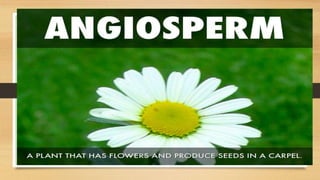
Angiosperms: Key Characteristics and Life Cycle
- 6. 09984612511
- 14. In the plant kingdom, the division Spermatophyta is divided into gymnosperms and angiosperms. The most diverse and dominant group of plants among the two are angiosperms, also referred to as Magnoliophyta. In common terms, angiosperms are all flowering plants. They are distinguished from gymnosperms, by their ability to flower and produce seeds enclosed in fruits.
- 15. Features That Distinguish Angiosperms Angiosperms have ovules that are enclosed in an ovary. There are two subtypes of angiosperms: monocotyledons and dicotyledons. The most prominent features of angiosperms is the ability to flower and produce fruits. There are over 250,000 species of angiosperms
- 16. 1.Angiosperms are able to grow in a variety of habitats. They can grow as trees, shrubs, bushes, as well as herbs. These plants have diploid (2n) sporophytes. Angiosperms have a distinctive underground root, as well as aerial shoot system.
- 17. 2.Angiosperms have very well- developed conducting tissues. These tissues include the xylem and the phloem arranged in form of vascular bundles. The xylem contains vessels. Similarly, phloem consists of sieve tubes and companion cells.
- 18. 3.The vascular bundles of monocotyledons are arranged in stems, in a cross-section. The dicotyledons have vascular bundles organized in form of a ring. A pith for storage, as well as cortex for strength and structure are found in the stem tissues. Growth of stem tissues takes place due to a layer of cambium cells. The outer part of the stem tissues is covered with a layer of epidermis
- 19. 4.The root system of angiosperms is also very complex. The roots also contain cortex, phloem, xylem, and epidermis. They have root hair that help in better absorption of water minerals from the soil. Absorption takes place by diffusion and active transport.
- 20. 5.The leaves carry out photosynthesis and are covered with a waxy cuticle to avoid water evaporation from leaves. There is absence of stomatal openings in the upper epidermis. This helps in prevention of excess transpiration. The stomatal openings are present in the lower epidermis.
- 21. 6.The flowers are one of the most differentiating features of angiosperms. They are the reproductive structures of angiosperms. The flower has a thalamus that is a short axis and four whorls of sporophylls arranged on the thalamus. The four whorls of floral leaves include calyx, corolla, androecium and gymnocium. The sepals, petals, stamens and carpels make up the whorls.
- 22. 7.The stamens produce pollen that helps in pollination when they reach the stigma. A pollen tube containing non-motile male gametes is produced after germination of a pollen grain. The pollen tube reaches the ovary through a style. Ovaries of an angiosperm contain a nucellus and two integuments containing a micropyle. Closed carpels that enclose the ovules help in prevention of self-fertilization.
- 23. 8.Prime features that distinguish angiosperms also include double, as well as triple fusion. This leads to formation of a zygote (2n) and triploid endosperm cell (3n). Endosperm cell produces endosperm and zygote develops into a sporophyte.
- 24. 9.Fertilization takes place by pollination, that includes insect pollination, wind pollination, etc. Endosperm is produced after fertilization and before the zygote undergoes its first division. The endosperm helps in providing nutrition to the developing embryo, as well as the seedlings. The fertilized ovule develops into seeds and then ripens into a fruit. The seeds are enclosed in the fruits and are dispersed by animals and humans who eat the fruit.
- 25. The Life Cycle of an Angiosperm Angiosperms are seed-producing plants that generate male and female gametophytes, which allow them to carry out double fertilization.
- 26. •Microspores develop into pollen grains, which are the male gametophytes, while megaspores form an ovule that contains the female gametophytes.
- 27. •In the ovule, the megasporocyte undergoes meiosis, generating four megaspores; three small and one large; only the large megaspore survives and produces the female gametophyte (embryo sac).
- 28. • When the pollen grain reaches the stigma, it extends its pollen tube to enter the ovule and deposits two sperm cells in the embryo sac
- 29. •The two available sperm cells allow for double fertilization to occur, which results in a diploid zygote (the future embryo) and a triploid cell (the future endosperm), which acts as a food store.
- 30. •Some species are hermaphroditic (stamens and pistils are contained on a single flower), some species are monoecious (stamens and pistils occur on separate flowers, but the same plant), and some are dioecious (staminate and pistillate flowers occur on separate plants).
- 31. Diversity of Angiosperms Angiosperms are classified in a single phylum: the Anthophyta. Modern angiosperms appear to be a monophyletic group, which means that they originated from a single ancestor. Flowering plants are divided into two major groups according to the structure of the cotyledons and pollen grains, among others
- 32. Monocots include grasses and lilies while eudicots or dicots form a polyphyletic group. However, many species exhibit characteristics that belong to either group; as such, the classification of a plant as a monocot or a eudicot is not always clearly evident.
- 33. Basal angiosperms are a group of plants that are believed to have branched off before the separation into monocots and eudicots because they exhibit traits from both groups. They are categorized separately in many classification schemes. The Magnoliidae (magnolia trees, laurels, and water lilies) and the Piperaceae (peppers) belong to the basal angiosperm group